Beginners Guides
Pancake Mix With Water or Milk

When deciding whether to use water or milk in your pancake mix, you are not just making a simple ingredient swap. This choice can affect the texture, taste, and overall enjoyment of your fluffy pancake stack.
But before we dive into the details of how water or milk affects pancake mix, let's consider the potential implications of this choice and how it may surprise you.
Key Takeaways
- Water alters the texture and consistency of the pancake batter, resulting in a lighter and fluffier final product.
- Milk enhances the richness and flavor of the pancake batter, contributing to a creamier texture.
- The choice of liquid impacts the overall taste and texture of the pancakes, with water resulting in a milder flavor and milk imparting a richer and creamier flavor.
- Milk adds more calories and essential nutrients to the pancake mix, while water lacks these nutritional benefits.
The Impact of Water on Pancake Mix
When water is used in pancake mix, it alters the texture and consistency of the batter, resulting in a lighter and fluffier final product. Understanding the impact of water on pancake mix involves delving into cooking techniques and recipe variations.
The addition of water to pancake mix affects its hydration and gluten development, which in turn influences the texture and structure of the pancakes. Water also plays a crucial role in activating the leavening agents present in the mix, leading to the desired rise and fluffiness.
Cooking techniques such as adjusting the water-to-mix ratio or incorporating seltzer water can further modify the pancake batter, yielding variations in texture and fluffiness. Additionally, recipe variations involving different types of water, such as sparkling water or flavored water, can introduce unique flavors and textures to the pancakes. Experimenting with water temperature, whether using cold or room temperature water, can also impact the overall outcome.
Benefits of Using Milk in Pancake Mix
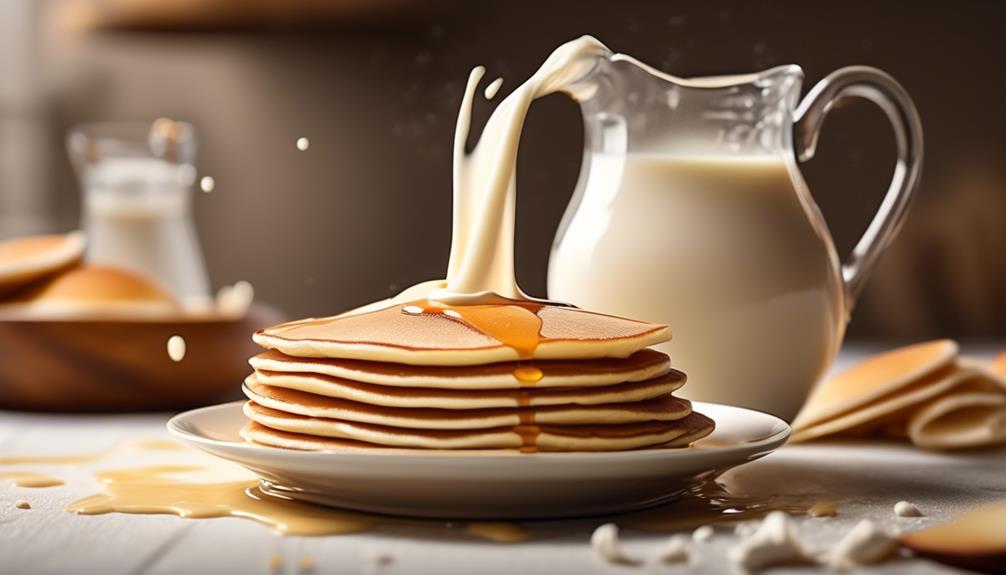
Using milk in pancake mix enhances the richness and flavor of the batter while contributing to a creamier texture in the final product. This occurs due to the presence of proteins and fats in milk, which interact with the other ingredients in the mix during cooking. When milk is used instead of water, the proteins and fats in the milk aid in creating a more tender and moist pancake. Additionally, the natural sugars present in milk contribute to the browning of the pancake, resulting in a desirable golden color and a distinct caramelized flavor.
Cooking techniques can be optimized when using milk in pancake mix. For instance, the sugars in milk facilitate the Maillard reaction, enhancing the overall flavor profile and color development of the pancake. Moreover, the fats in milk lend a richer mouthfeel to the pancake, making it more satisfying and indulgent.
When considering ingredient substitution, using milk in pancake mix offers a simple yet effective way to elevate the taste and texture of the final product. By incorporating milk, the batter becomes more versatile, allowing for the creation of pancakes with a more complex flavor profile and a softer, more luxurious texture.
Adjusting Consistency With Water or Milk
To adjust the consistency of pancake batter, one can incorporate either water or milk as a liquid component. The choice between water and milk plays a crucial role in adjusting the texture of the pancake batter to meet personal taste preferences.
Water is neutral in flavor and will result in a lighter, more airy texture. It's ideal for those who prefer a less rich and heavy pancake.
On the other hand, using milk will yield a richer, creamier texture and add a subtle sweetness to the pancakes. The fat and proteins in milk contribute to a denser, more indulgent pancake.
When adjusting the consistency, it's essential to consider how the choice of liquid will impact the overall taste and texture of the pancakes. By carefully adjusting the amount of water or milk added to the pancake mix, one can tailor the batter to achieve the desired thickness and mouthfeel.
Ultimately, the decision to use water or milk for adjusting the consistency of pancake batter depends on individual taste preferences and the desired pancake texture.
Flavor Considerations: Water Vs. Milk
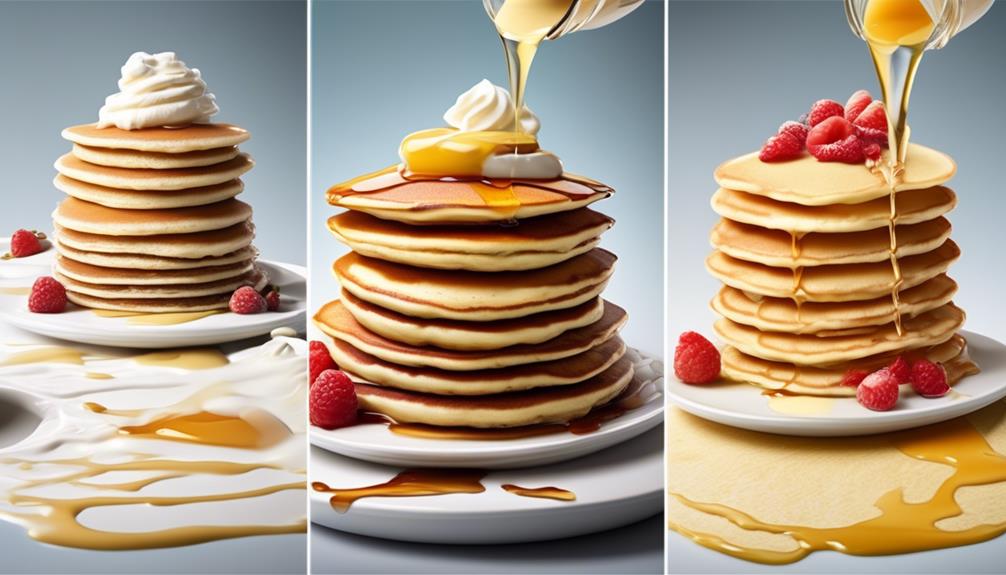
Considering the impact of water and milk on pancake batter consistency, the flavor implications of using either liquid are crucial in determining the desired taste profile and overall sensory experience of the pancakes.
Taste preference is a significant factor when deciding between water and milk. Milk tends to impart a richer and creamier flavor due to its fat and protein content, enhancing the overall taste of the pancakes. In contrast, water may result in a milder flavor, allowing other ingredients such as fruits or syrups to stand out more prominently.
Texture is also influenced by the choice of liquid. Milk contributes to a softer and more tender texture, while water may lead to a slightly drier and less rich mouthfeel.
Ingredient compatibility is another aspect to consider, as the use of milk may complement certain ingredients like chocolate chips or nuts, enhancing their flavors and textures.
Additionally, the cooking process can be affected by the choice of liquid, as milk's sugars and proteins can lead to more browning during the cooking process, adding depth to the flavor profile.
Ultimately, understanding these flavor considerations is essential for achieving the desired taste and texture in pancakes.
Nutritional Comparison: Water and Milk in Pancake Mix
When comparing the nutritional content of pancake batter made with water versus that made with milk, it's essential to consider the differences in protein, fat, and overall caloric value.
- Caloric Content: Milk adds more calories to the pancake mix due to its fat content, whereas water contributes no additional calories.
- Nutrient Profile: Milk enriches the pancake batter with essential nutrients such as calcium, vitamin D, and protein, while water lacks these nutritional benefits.
- Dietary Restrictions, Allergies: Individuals with lactose intolerance or dairy allergies may need to use water instead of milk in their pancake mix. This substitution can significantly impact the nutrient content of the pancakes, making it crucial for those with dietary restrictions to find alternative sources of essential nutrients.
When considering the nutritional aspects, it's clear that milk offers a more nutrient-dense option for pancake batter. However, for individuals with dietary restrictions or allergies, water can be a suitable alternative. It's important to weigh the nutritional benefits against dietary needs and make an informed decision based on individual circumstances.
Frequently Asked Questions
Can I Use Any Other Liquid Besides Water or Milk in Pancake Mix?
Yes, you can use alternative liquids such as fruit juice or alternative milks in pancake mix. These can add unique flavors and textures to your pancakes.
When using alternative liquids, consider adjusting the recipe slightly to account for differences in consistency. Experiment with different options and ratios to achieve your desired texture.
Additionally, consider how the alternative liquid may interact with other ingredients, such as baking soda, and how it may affect pancake toppings.
What Is the Best Type of Milk to Use in Pancake Mix?
When considering the best type of milk for pancake mix, it's important to factor in dietary preferences and flavor profiles. Options like almond milk and soy milk offer a nutty undertone, while oat milk and coconut milk provide a creamy texture. Each type of milk contributes differently to the overall taste and consistency of the pancakes.
Understanding these nuances allows for a more informed decision when selecting the ideal milk for pancake mix.
Can I Use a Combination of Water and Milk in Pancake Mix?
Yes, using a combination of water and milk in pancake mix can yield great results. It provides a balance between richness and hydration.
While the traditional liquid for pancake mix is milk, incorporating water can help achieve a lighter texture.
Additionally, using juice or soda as a liquid in pancake mix can add unique flavors.
Buttermilk is also beneficial as it imparts a tangy flavor and helps create a tender crumb.
How Does Using Buttermilk in Pancake Mix Affect the Taste and Texture?
Enhancing flavor and improving fluffiness, buttermilk in pancake mix is a game-changer. Its acidity tenderizes gluten, resulting in a more tender and moist texture.
The tangy flavor of buttermilk adds complexity and depth, enhancing the overall taste profile of the pancakes. This combination creates a superior pancake experience, leading to a noticeable improvement in both taste and texture.
Buttermilk truly elevates the pancake to the next level.
Are There Any Dairy-Free Alternatives to Milk That Can Be Used in Pancake Mix?
We've explored dairy-free alternatives extensively and found that using oat milk or almond milk in pancake mix can yield fantastic results. These substitutes offer a creamy texture and subtly sweet flavor, enhancing the overall taste.
When considering cooking tips, it's crucial to maintain the correct consistency, adjusting the amount of milk alternative as needed. This attention to detail ensures that the pancakes turn out just as delicious as traditional milk-based ones.
What Type of Liquid Should I Use to Make Pancake Mix?
For fluffy pancake recipes, using buttermilk or club soda in the pancake mix can help achieve the desired texture. These liquids react with the other ingredients to create a light and airy batter, resulting in perfectly fluffy pancakes.
Conclusion
In summary, the choice between using water or milk in pancake mix can have a significant impact on the final product. While water may result in a lighter texture, milk can add richness and depth of flavor.
It's important to consider the desired consistency and flavor profile when making this decision. Ultimately, the choice between water and milk is a crucial factor in creating the perfect pancake experience, like the difference between a gentle breeze and a powerful gust of wind.
- About the Author
- Latest Posts
Introducing Ron, the home decor aficionado at ByRetreat, whose passion for creating beautiful and inviting spaces is at the heart of his work. With his deep knowledge of home decor and his innate sense of style, Ron brings a wealth of expertise and a keen eye for detail to the ByRetreat team.
Ron’s love for home decor goes beyond aesthetics; he understands that our surroundings play a significant role in our overall well-being and productivity. With this in mind, Ron is dedicated to transforming remote workspaces into havens of comfort, functionality, and beauty.
Beginners Guides
Mug Painting Inspo
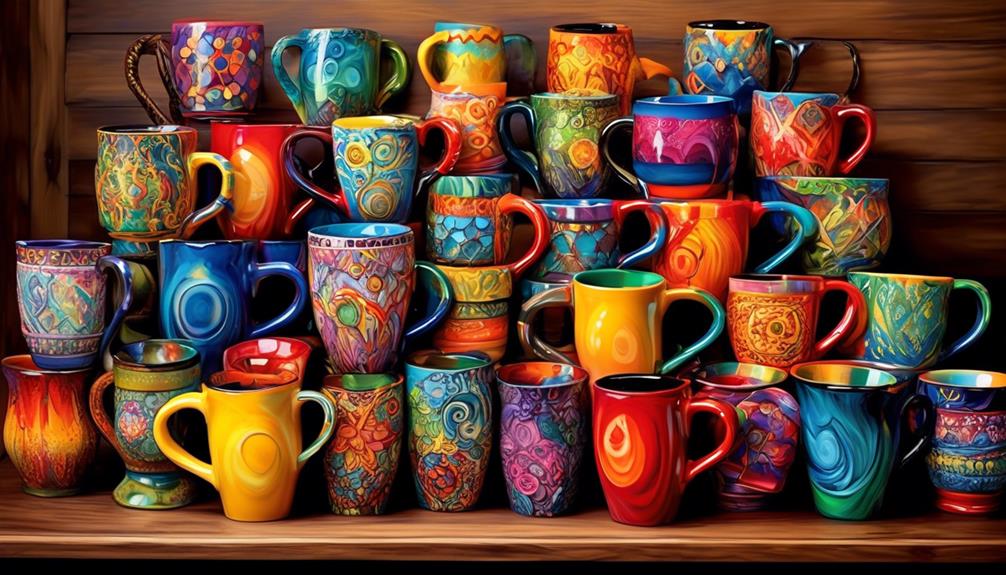
We have all felt the delight of drinking a warm drink from a beautifully hand-painted mug that enhances the entire experience.
But have you ever wondered how those stunning designs come to life? There's a world of endless inspiration waiting to be explored, from vibrant floral patterns to whimsical animal characters and intricate geometric shapes.
Whether you're a seasoned artist or just dipping your brush into the world of mug painting, there's something for everyone.
So, grab your favorite mug and let's uncover the endless possibilities of mug painting inspiration.
Key Takeaways
- Mastering brush strokes and understanding pressure and style are essential for creating different textures and effects in mug painting.
- Color blending techniques, including mixing and layering different hues, can help achieve seamless transitions and captivating gradients in mug designs.
- Using bright watercolors and paying attention to intricate details can create colorful floral designs on mugs, incorporating delicate veins and varied textures on petals and leaves.
- Whimsical animal characters can be created with vibrant colors, playful patterns, and imaginative features like expressive eyes and wide grins, infusing personality and charm into mug designs.
Mug Painting Techniques
When painting a mug, it's essential to understand the various techniques that can bring your design to life with vibrant colors and lasting durability. One of the fundamental aspects of mug painting is mastering brush strokes. The direction, pressure, and style of your brush strokes can greatly influence the final look of your design. The way the bristles glide or dab against the surface can create different textures and effects, adding depth and character to your artwork. Experimenting with various brush stroke techniques can help you achieve the precise look you desire, whether it's bold and expressive or delicate and intricate.
Color blending is another crucial technique in mug painting. It involves mixing and layering different hues to achieve seamless transitions and captivating gradients. Understanding color theory and the properties of different paint mediums is essential for successful blending. Whether you prefer a smooth ombre effect or a striking contrast between colors, mastering the art of color blending can elevate your mug painting to a professional level. By skillfully blending colors, you can create captivating designs that are visually stunning and unique.
Colorful Floral Designs
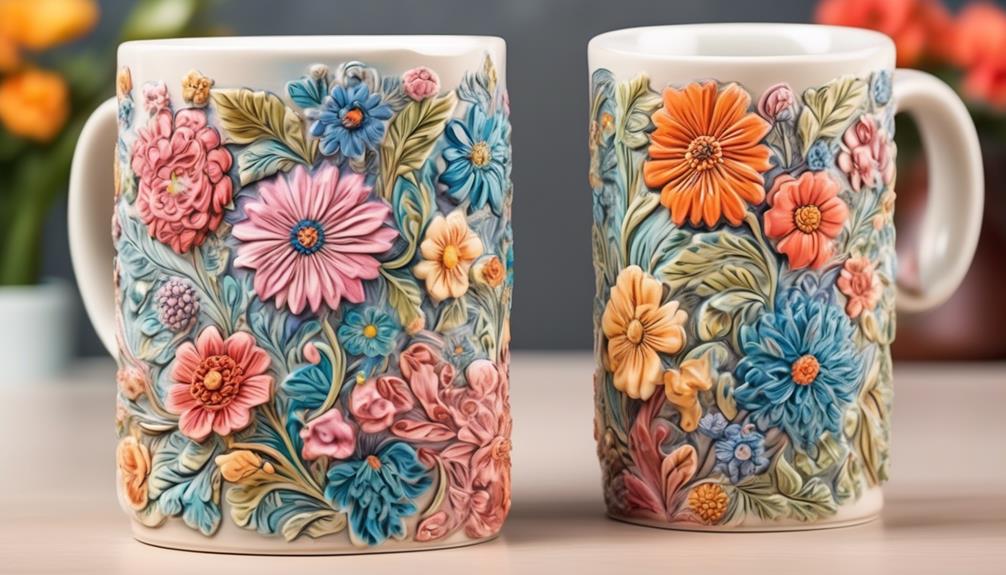
Mastering brush strokes and color blending in mug painting sets the foundation for creating vibrant and enduring colorful floral designs on your mugs. When painting colorful floral designs, it's essential to use bright watercolors to achieve the lively and captivating look. Adding intricate details to the petals and leaves will elevate the overall visual appeal of your mug.
| Petals | Leaves | Background |
|---|---|---|
| Delicate and vibrant | Varied shades of green | Soft pastel hues |
| Layered with highlights | Veins and textures | Subtle washes of color |
| Intricate patterns | Diverse shapes | Blended gradients |
Using bright watercolors to paint the petals will make them appear lively and eye-catching. Incorporating intricate details, such as delicate veins and varied textures on the leaves, adds depth and visual interest to the design. Additionally, paying attention to the background by using soft pastel hues and subtle washes of color will ensure that the floral elements stand out beautifully. These elements combined will result in a mug that exudes charm and elegance, making it a delightful addition to your collection.
Whimsical Animal Characters
To create whimsical animal characters on your mugs, begin by selecting vibrant colors and playful patterns to infuse personality and charm into your designs. When envisioning whimsical animal characters on your mug, think about using lively hues such as bright yellows, ocean blues, and grassy greens to bring a sense of joy and liveliness to your creation.
Additionally, consider incorporating playful patterns like polka dots, stripes, or even tiny paw prints to add a touch of whimsy and fun to your design. Here's a visual guide to help you bring these ideas to life:
- Imagine a cheerful yellow giraffe with a long neck and playful spots cavorting across the mug's surface. Its long eyelashes and friendly smile add a delightful touch to the design.
- Picture a mischievous monkey swinging from a branch, surrounded by vibrant green leaves and playful bananas. The monkey's expressive eyes and wide grin capture the essence of playful curiosity.
These colorful and imaginative ideas will surely bring a smile to your face every time you reach for your whimsical animal character mug.
Geometric Patterns and Shapes
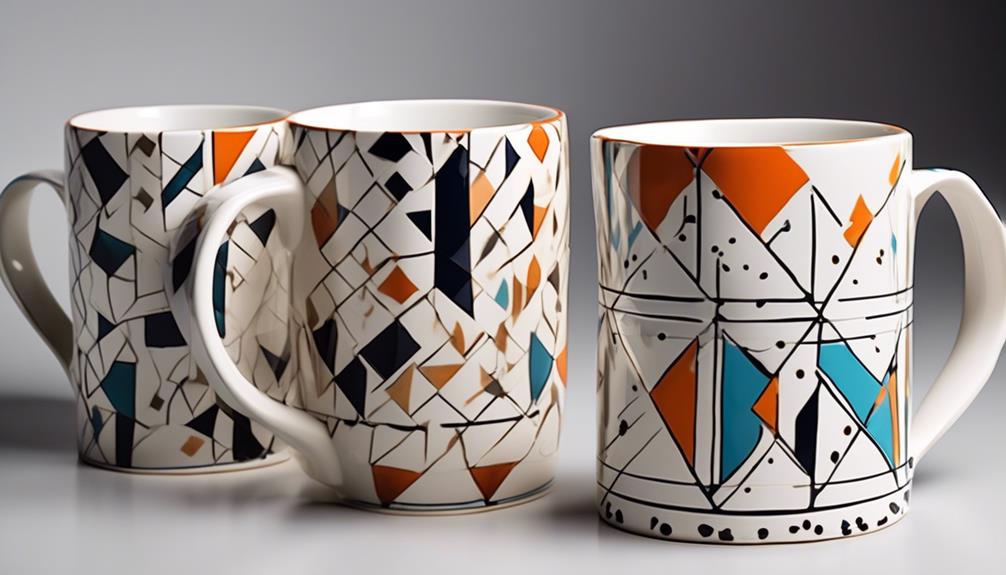
Exploring the world of geometric patterns and shapes brings an exciting dimension to mug painting, allowing for the creation of captivating designs that play with symmetry and precision. Geometric art provides an endless array of possibilities, from simple lines and circles to intricate abstract shapes. When incorporating geometric patterns into mug painting, one can experiment with various arrangements of squares, triangles, hexagons, and other shapes to create visually striking designs. The precise nature of geometric patterns allows for meticulous detailing and clean, sharp lines, resulting in a modern and sophisticated aesthetic.
Abstract shapes, such as spirals, chevrons, and tessellations, offer an opportunity to add depth and complexity to mug designs. These shapes can be repeated to form intricate patterns, or used individually to create a focal point on the mug's surface. By playing with the scale and arrangement of these shapes, one can achieve a sense of movement and rhythm within the design, adding visual interest and dynamic energy to the finished piece.
Whether opting for a minimalist approach or a bold, graphic style, geometric patterns and shapes open up a world of creative possibilities for elevating mug painting to a whole new level of artistry.
Inspirational Quotes and Phrases
Adorning mugs with inspirational quotes and phrases infuses them with meaningful and uplifting messages, adding a personal touch to each sip. It's like wrapping your hands around a warm cup of motivation. When you reach for your mug, you might find yourself inspired by words that resonate deep within your soul, fueling your day with positivity and purpose.
Imagine sipping from a mug adorned with motivational mantras, such as 'Embrace the journey' or 'You are capable of amazing things.' These uplifting messages serve as gentle reminders to stay focused on our goals and to approach each day with optimism. Each sip becomes a moment of reflection, as the words on the mug offer encouragement and strength.
- Motivational Mantras
- 'Believe in yourself'
- 'You are enough'
- Uplifting Messages
- 'Choose joy'
- 'Dream big'
These phrases, carefully painted on a mug, hold the power to uplift the spirit and set a positive tone for the day.
Frequently Asked Questions
Can I Use Regular Acrylic Paint for Mug Painting?
Yes, regular acrylic paint can be used for mug painting. However, there are also specialized acrylic paint alternatives designed specifically for use on ceramics. These alternatives offer better durability and adherence to the mug surface.
To achieve the best results, it's important to properly prepare the mug surface. This involves cleaning it thoroughly and, if necessary, using a primer specifically designed for ceramics. By doing this, you can ensure that the paint will adhere well to the mug surface and create a long-lasting design.
What Type of Brush Should I Use for Painting Details on Mugs?
When painting details on mugs, it's crucial to use fine-tipped brushes, such as liner or round brushes, to achieve precision. These brushes allow for intricate designs on the curved mug surface.
When painting, it's essential to use controlled brushstrokes and a steady hand to create clean and crisp details.
Experiment with different painting techniques, like stippling or dry brushing, to achieve varying textures and effects on the mug.
How Can I Make My Mug Designs Dishwasher Safe?
To make mug designs dishwasher safe, we ensure temperature resistance and design durability. Apply a sealant that can withstand heat and won't compromise the color longevity. This helps to protect the design and maintain its quality even after multiple washes.
It's essential to use a sealant specifically formulated for ceramics to ensure the best results. With proper sealant application, your mug designs will stay vibrant and dishwasher safe.
Are There Any Special Techniques for Painting on Ceramic Mugs?
When painting on ceramic mugs, it's crucial to start with proper preparation of the mug surface to ensure the paint adheres well. The temperature at which the painting is done also impacts the final result.
As for design trends, custom mug ideas are all the rage. Incorporating personalized elements and unique patterns can make your mug stand out. These techniques help create stunning and durable designs that can withstand regular use and washing.
Where Can I Find Inspiration for Creating My Own Unique Mug Designs?
When seeking inspiration for creating our own unique mug designs, we often explore various sources to develop our color palette and design themes. Inspirational sources like nature, art, and cultural motifs can influence our mug painting styles.
We look into different painting techniques, such as watercolor effects or intricate patterns, to spark our creativity. By immersing ourselves in diverse artistic expressions, we find the inspiration to craft one-of-a-kind mug designs.
What Are Some Inspiring Designs for Painting a Coffee Mug?
Looking for inspiration for your next painting a coffee mug tutorial? Consider vibrant floral patterns, geometric shapes, or abstract watercolor designs. Add a personal touch with monograms, animals, or uplifting quotes. Use colorful ceramic paint for durability and finish with a food-safe sealant for long-lasting beauty.
Conclusion
After exploring various mug painting techniques, from colorful floral designs to whimsical animal characters and geometric patterns, we're inspired to bring our own unique touch to our mugs.
The possibilities are endless, and we can't wait to unleash our creativity and personalize our morning coffee routine.
Stay tuned for our next mug painting project as we dive into the world of inspirational quotes and phrases, adding a touch of motivation to our daily cup of joe.
- About the Author
- Latest Posts
Introducing Ron, the home decor aficionado at ByRetreat, whose passion for creating beautiful and inviting spaces is at the heart of his work. With his deep knowledge of home decor and his innate sense of style, Ron brings a wealth of expertise and a keen eye for detail to the ByRetreat team.
Ron’s love for home decor goes beyond aesthetics; he understands that our surroundings play a significant role in our overall well-being and productivity. With this in mind, Ron is dedicated to transforming remote workspaces into havens of comfort, functionality, and beauty.
Beginners Guides
Pros and Cons of Having a Creek on Your Property
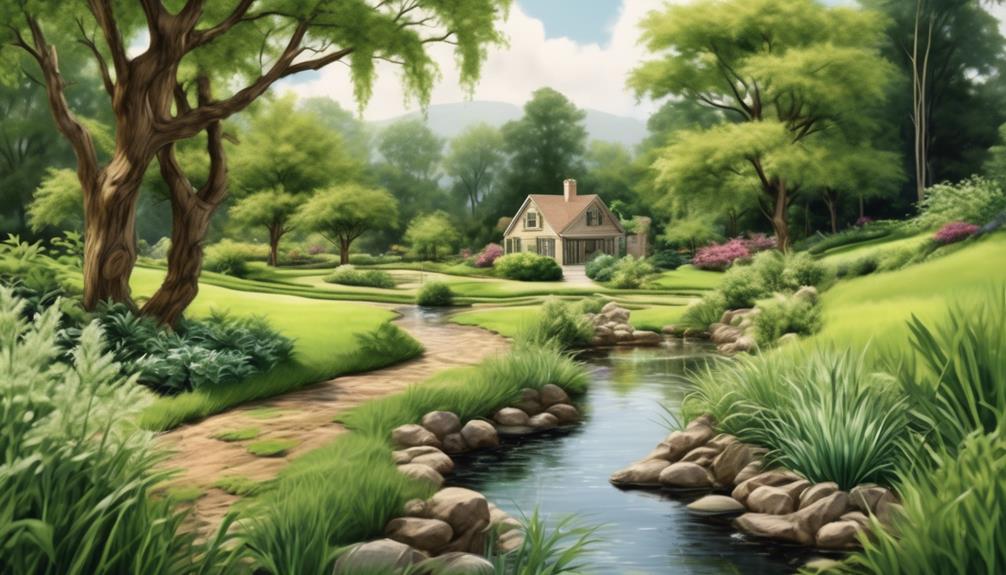
Were you aware that more than 100 million Americans reside within 100 meters of a river or stream?
Having a creek on our property can offer a peaceful and picturesque setting for our homes, but it also comes with its own set of challenges.
From potential environmental benefits to property value impact, there are various factors to consider when it comes to having a creek on our property.
Let's explore the pros and cons of this unique feature and how it can impact our lives and our surroundings.
Key Takeaways
- Having a creek on your property increases biodiversity and provides natural irrigation for plants and trees.
- A creek creates a wildlife habitat, attracting various species of birds, amphibians, and mammals.
- It supports the overall health of the ecosystem by providing a diverse range of flora and fauna.
- Having a creek enhances the aesthetic value of the property and potentially increases its market value.
Advantages of Having a Creek
Having a creek on your property offers numerous benefits. It increases biodiversity and provides natural irrigation for plants and trees. The presence of a creek creates a wildlife habitat, attracting various species of birds, amphibians, and mammals. The riparian area around the creek provides shelter, nesting sites, and a water source, essential for the survival of many species. Additionally, the creek contributes to the overall health of the ecosystem by supporting a diverse range of flora and fauna.
Furthermore, having a creek on your property opens up a range of recreational opportunities. It provides a serene and picturesque setting for activities such as fishing, hiking, and birdwatching. The soothing sound of running water and the lush vegetation along the creek can create a peaceful and relaxing environment for outdoor recreation.
Moreover, the presence of a creek adds aesthetic value to the property, enhancing its overall appeal and potentially increasing its market value.
Environmental Benefits
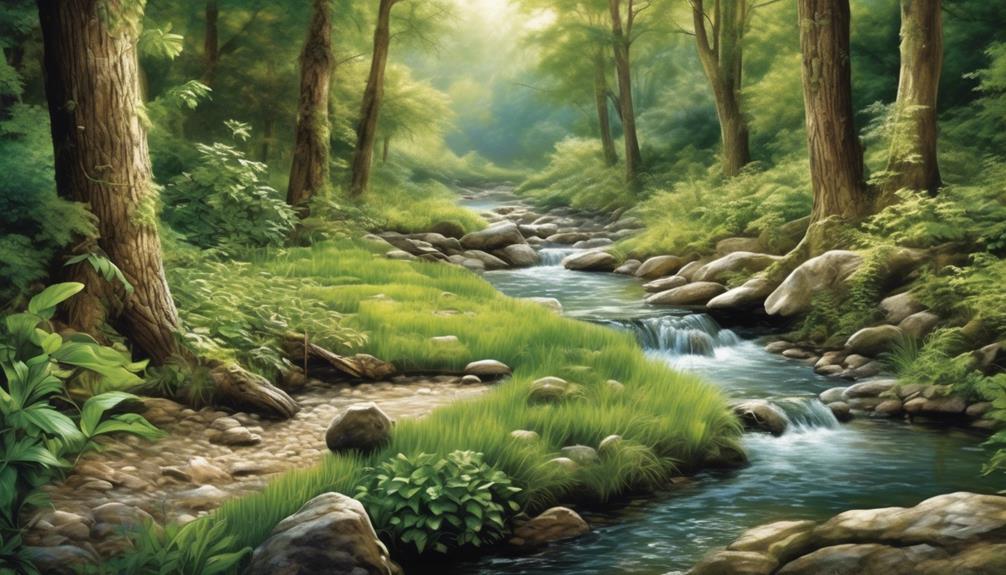
One can observe a range of environmental benefits associated with the presence of a creek on a property, including its role in supporting diverse ecosystems and promoting natural water conservation.
—
| Environmental Benefit | Description | Example |
|---|---|---|
| Wildlife Habitat | Creeks provide habitats for a variety of species, including fish, amphibians, insects, and birds. | The presence of a creek on a property can attract a diverse range of wildlife. |
| Water Quality | Creeks act as natural filters, helping to improve water quality by trapping sediments and filtering out pollutants. | The presence of a creek can lead to cleaner water downstream. |
—
Creeks are essential for preserving wildlife habitat. They provide a source of water for various species, supporting the food chain and promoting biodiversity. Furthermore, the presence of a creek can improve water quality as it serves as a natural filter, reducing the impact of pollutants and sediments before they reach larger bodies of water. This environmental benefit is crucial for maintaining healthy ecosystems and promoting sustainable water management practices.
Potential Hazards and Risks
Supporting diverse ecosystems and promoting natural water conservation, the presence of a creek on a property also introduces potential hazards and risks that should be carefully considered. One significant concern is erosion control. The flow of water in a creek can cause soil erosion, potentially leading to the loss of land and damage to infrastructure. This can be particularly problematic in areas with steep slopes or unstable soil. Implementing erosion control measures such as riprap, retaining walls, or planting vegetation can help mitigate this risk.
Another potential hazard is flood prevention. While creeks provide natural drainage for excess water, they can also pose a risk of flooding, especially during heavy rainfall or snowmelt. Property owners need to be mindful of the potential for creek overflow and take appropriate precautions to protect their land and structures. This may involve creating floodplains, constructing embankments, or even installing flood barriers in extreme cases.
Property Value Impact
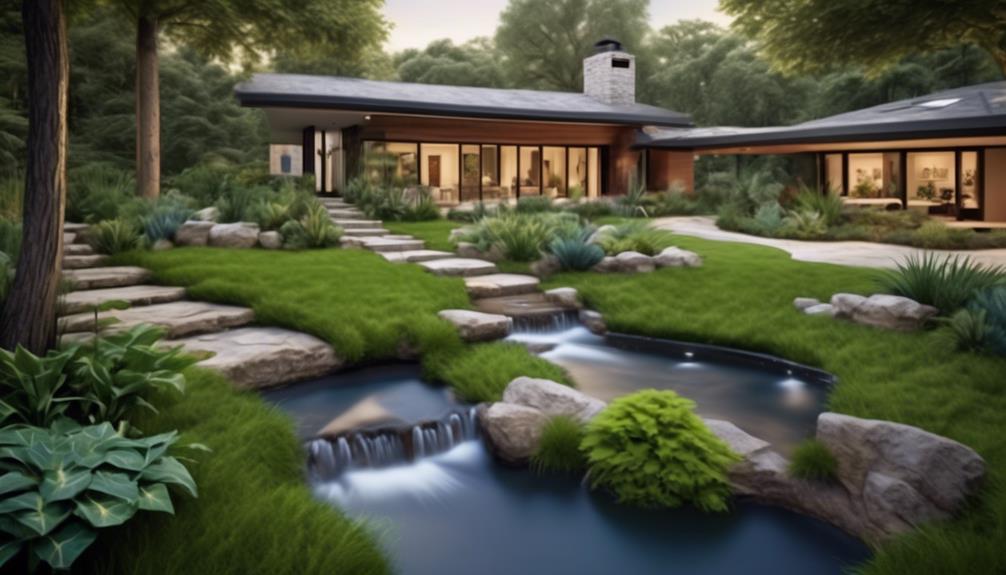
The presence of a creek on a property can significantly impact its overall market value, with various factors contributing to both positive and negative effects. When considering the impact of a creek on property value, it's essential to weigh the following factors:
- Impact on Landscaping: A creek can enhance the aesthetic appeal of a property, providing a serene and natural landscape that's attractive to potential buyers. However, it may also require additional maintenance and landscaping to prevent erosion and maintain a tidy appearance.
- Wildlife Attraction: The presence of a creek can create a habitat for diverse wildlife, adding to the allure of the property. Birdwatching, fishing, and the peaceful coexistence with nature may be appealing to prospective buyers. Conversely, some individuals may view wildlife as a nuisance or a potential hazard, especially if the wildlife population becomes overwhelming.
- Potential for Flooding: While a creek can add charm to a property, it also raises concerns about flood risk. Properties near creeks are more susceptible to flooding, which may be a deterrent for potential buyers and impact the overall property value.
- Waterfront Premium: Properties with a creek frontage often command a premium in the real estate market due to the desirability of waterfront living. However, this premium can vary depending on the size, accessibility, and condition of the creek.
Understanding the nuanced impact of a creek on property value is crucial for homeowners and real estate professionals when assessing the market worth of such properties.
Creek Maintenance and Management
Considering the implications of a creek's impact on property value, it's essential to address the maintenance and management aspects associated with owning a property with a creek. Erosion control and bank stabilization are fundamental concerns when managing a creek on your property.
Erosion can lead to the loss of land and property, and it can also contribute to water pollution. Implementing erosion control measures such as planting native vegetation, installing retaining walls, and using erosion control blankets can help stabilize the banks and prevent erosion.
Habitat restoration and wildlife preservation are also crucial components of creek management. A healthy creek ecosystem supports a diverse range of wildlife and contributes to the overall biodiversity of the area. To promote habitat restoration and wildlife preservation, property owners can engage in activities such as removing invasive species, planting native vegetation, and creating wildlife corridors along the creek.
Balancing the needs of human habitation with the preservation of the natural environment is vital when managing a creek on your property. Seeking expert guidance and implementing sustainable management practices can help ensure that the creek remains a valuable and ecologically sound feature of your property.
Frequently Asked Questions
Are There Any Legal Restrictions or Regulations for Using the Creek on My Property?
We must ensure regulatory compliance when using the creek on our property.
Legal restrictions may apply to water usage, requiring us to obtain permits or follow specific guidelines.
It's important to consider the environmental impact of our actions on the creek.
Understanding any water usage restrictions and taking steps to minimize our impact will help us maintain a positive relationship with the environment and stay in compliance with regulations.
How Does Having a Creek Affect the Local Wildlife and Ecosystem?
Having a creek on our property significantly impacts the local wildlife and ecosystem.
The presence of a creek creates a diverse and thriving habitat for various species, supporting biodiversity. It provides water, shelter, and food sources for many organisms.
Moreover, the creek contributes to the overall health of the ecosystem by regulating water flow, filtering pollutants, and maintaining a balanced environment.
These aspects make the creek a vital component of the local wildlife and ecosystem.
Will Having a Creek on My Property Increase My Insurance Costs?
Having a creek on our property may impact our insurance costs. The proximity of a creek can increase the risk of flooding and water damage, potentially leading to higher insurance premiums.
Additionally, while it may positively impact property value due to the scenic and environmental benefits, the potential for increased insurance costs should be carefully considered.
The environmental impact on the surrounding area should also be assessed to fully understand the implications of having a creek on our property.
What Are the Potential Long-Term Effects of Erosion Caused by the Creek on My Property?
Having a creek on our property could potentially impact the environment. The long-term effects of erosion caused by the creek may lead to soil instability and loss of land. However, implementing erosion control measures can mitigate these impacts.
For instance, constructing retaining walls along the creek can help stabilize the soil and prevent erosion. Overall, it's crucial to consider the potential environmental impact and implement measures for soil stability and erosion control when owning a property with a creek.
Are There Any Specific Permits or Permissions Required for Making Changes to the Creek or Its Surroundings on My Property?
We must consider permit requirements and the potential environmental impact when making changes to the creek or its surroundings on our property.
It's essential to check with local authorities about any necessary permits for construction or alterations near the creek.
Additionally, altering the creek's surroundings can have environmental implications, such as affecting the natural flow of water and impacting local wildlife habitats.
Therefore, thorough research and consideration are crucial before making any changes.
Can a Creek on Your Property Affect the Timeframe for a Landlord to Fix a Furnace?
Having a creek on your property can indeed affect the landlord furnace repair timeframes. If the furnace is located near the creek, it may be more susceptible to water damage and corrosion. This could lead to longer repair times and potential complications for both the landlord and the tenant.
Conclusion
In conclusion, having a creek on your property can provide numerous environmental benefits, such as improving water quality and supporting wildlife.
However, it also comes with potential hazards and risks, as well as the need for regular maintenance and management.
While it can increase property value, it's important to weigh the pros and cons before deciding if having a creek on your property is the right choice for you.
- About the Author
- Latest Posts
Introducing Ron, the home decor aficionado at ByRetreat, whose passion for creating beautiful and inviting spaces is at the heart of his work. With his deep knowledge of home decor and his innate sense of style, Ron brings a wealth of expertise and a keen eye for detail to the ByRetreat team.
Ron’s love for home decor goes beyond aesthetics; he understands that our surroundings play a significant role in our overall well-being and productivity. With this in mind, Ron is dedicated to transforming remote workspaces into havens of comfort, functionality, and beauty.
Beginners Guides
Temperature for Pancakes on Griddle

How can one achieve perfectly fluffy pancakes with a golden-brown exterior?
As we stand over the griddle, pondering the ideal temperature for our pancake batter, it's essential to consider the science behind achieving that picture-perfect result.
We've all experienced the frustration of unevenly cooked pancakes or those that end up burnt on the outside and undercooked inside.
But fear not, as we explore the crucial factors that determine the griddle temperature, we'll uncover the key to mastering the art of pancake perfection.
Key Takeaways
- Optimal griddle temperature is crucial for evenly cooked and golden pancakes.
- Maintaining griddle temperature around 375°F (190°C) is crucial for even cooking and preventing undercooked or overly browned results.
- Factors such as griddle material and thickness, as well as batter consistency, affect the ideal griddle temperature for pancakes.
- Testing griddle heat using methods like infrared thermometers and visual cues, as well as adjusting temperature based on batter type, can ensure optimal pancake cooking results.
Importance of Griddle Temperature
Maintaining the optimal griddle temperature is crucial for achieving evenly cooked and perfectly golden pancakes. Heat distribution across the cooking surface is essential to ensure that each pancake cooks uniformly. When the griddle is too cold, the pancakes may turn out pale and undercooked, whereas if it's too hot, they may become overly browned on the outside while remaining raw inside. To achieve the ideal heat distribution, preheat the griddle to around 375°F (190°C) before pouring the batter.
The cooking surface plays a significant role in determining the griddle temperature for pancakes. A non-stick surface is preferable as it ensures even heat distribution and prevents pancakes from sticking, allowing for a smooth flip. Additionally, the material of the griddle can impact temperature control. Cast iron griddles, for example, are excellent at retaining and evenly distributing heat, making them a popular choice for achieving consistent pancake results.
Ideal Temperature Range for Pancakes

To achieve the ideal heat distribution for evenly cooked and perfectly golden pancakes, the optimal temperature range for the griddle is around 375°F (190°C), ensuring uniform cooking and preventing undercooked or overly browned results. Maintaining the griddle within this temperature range is crucial for achieving pancakes with the desired texture and appearance.
Here are some essential considerations for the ideal temperature range:
- Cooking Time
At 375°F (190°C), pancakes typically take 2-3 minutes per side to cook to perfection. This temperature allows for the development of a beautifully golden-brown color while ensuring that the pancakes are cooked through evenly.
- Batter Consistency
A moderately thick batter is ideal for cooking pancakes at this temperature. The batter should be pourable but not overly runny, allowing it to spread naturally on the griddle without becoming too thin and resulting in uneven cooking.
- Heat Adjustment
It's important to monitor the griddle's temperature throughout the cooking process. Adjusting the heat as needed ensures that the griddle maintains the ideal temperature range, resulting in consistently delicious pancakes.
Factors Affecting Griddle Temperature
Analyzing the conductivity of the griddle and its material composition is crucial in understanding the factors influencing the temperature during pancake preparation. Heat distribution across the cooking surface is determined by the griddle's material and thickness. Conductive materials like aluminum and copper distribute heat evenly, ensuring consistent pancake cooking. Conversely, griddles with uneven heat distribution can result in unevenly cooked pancakes.
Additionally, the thickness of the griddle impacts its ability to retain heat. Thicker griddles may take longer to preheat, but once heated, they provide a more stable cooking temperature. The cooking surface, whether it's non-stick, cast iron, or chrome-plated steel, also influences temperature. Non-stick surfaces distribute heat well but may not withstand high temperatures, while cast iron retains heat effectively but requires more time to reach the desired temperature. Chrome-plated steel offers good heat distribution and durability.
Understanding these factors allows for precise temperature control, leading to perfectly cooked pancakes.
Tips for Testing Griddle Heat

When testing griddle heat, it's essential to use an infrared thermometer to accurately measure the surface temperature before cooking pancakes. This ensures precision in achieving the ideal heat level for perfect pancakes. Here are some tips for testing griddle heat:
- Testing Methods
- Conduct a spot test: Use the infrared thermometer to take multiple readings across the griddle surface to check for any hotspots or temperature variations.
- Time and observation: Allow the griddle to preheat for the recommended time and observe any visual cues such as a slight shimmering of the cooking surface to indicate the attainment of the desired heat level.
- Water droplet test: Sprinkle a few drops of water onto the griddle. The water should sizzle and evaporate almost instantly when the griddle is at the right temperature for cooking pancakes.
These testing methods, along with the use of heat indicators like infrared thermometers, are crucial for achieving consistent and optimal griddle heat for preparing delicious pancakes. Mastering these techniques will lead to perfectly cooked pancakes every time.
Adjusting Temperature for Different Pancake Types
Different types of pancakes may require specific adjustments to the griddle temperature to achieve optimal cooking results. When dealing with different pancake types, it's essential to consider the batter consistency and cooking time to ensure the best outcomes.
Firstly, the batter consistency plays a crucial role in determining the griddle temperature. Thicker batters, such as those used for fluffy buttermilk pancakes, require lower temperatures to ensure that the insides are fully cooked without burning the exterior. Thinner batters, common in recipes for crepes, require higher temperatures to quickly set the batter and achieve the desired delicate texture.
Secondly, cooking time is closely linked to griddle temperature and batter consistency. Thicker batters not only require lower temperatures but also longer cooking times to ensure that the center is thoroughly cooked. Conversely, thinner batters, when cooked at higher temperatures, have shorter cooking times to avoid overcooking or burning.
Understanding the unique characteristics of different pancake batters is essential for adjusting the griddle temperature effectively. By considering both batter consistency and cooking time, one can achieve the perfect pancake results for each type, ensuring a delightful culinary experience.
Frequently Asked Questions
Can I Use an Infrared Thermometer to Measure the Griddle Temperature Accurately?
Yes, we can use an infrared thermometer to measure the griddle temperature accurately. It provides precise readings, ensuring effective temperature control techniques.
Infrared thermometers are suitable for this purpose, allowing for accurate measurement of the griddle temperature. This is essential for achieving optimal cooking conditions and ensuring consistent results.
What Is the Best Way to Maintain a Consistent Griddle Temperature While Cooking Multiple Batches of Pancakes?
Maintaining consistent griddle temperature while cooking multiple batches of pancakes is crucial for even heat distribution.
To achieve this, we regulate the heat output and monitor the griddle's surface temperature regularly.
Ensuring the griddle is preheated to the optimal temperature and making slight adjustments as needed helps maintain a uniform cooking environment.
How Does the Type of Batter Affect the Ideal Griddle Temperature for Cooking Pancakes?
When considering the ideal griddle temperature for cooking pancakes, the type of batter significantly impacts the outcome.
Batter consistency directly influences how the pancakes cook and their overall texture. A thicker batter may require a slightly lower temperature to ensure the pancakes cook evenly and thoroughly.
Conversely, a thinner batter may benefit from a slightly higher temperature to achieve the perfect golden brown color and texture without overcooking or burning.
Are There Any Special Considerations for Cooking Gluten-Free or Vegan Pancakes at a Specific Griddle Temperature?
When cooking gluten-free batter or vegan alternatives, it's essential to consider the specific characteristics of these batters. Gluten-free batters may require a slightly lower cooking temperature to avoid burning or uneven cooking due to their different composition.
Vegan alternatives, such as those using plant-based milk, can also affect the cooking process, requiring adjustments to achieve the desired texture and browning.
Understanding these unique characteristics is crucial for achieving optimal results when cooking gluten-free or vegan pancakes.
Is There a Recommended Temperature for Cooking Pancakes on an Outdoor Griddle or Campfire?
When cooking pancakes on an outdoor griddle, the ideal temperature is around 375°F for a perfect pancake consistency. This temperature ensures that the pancakes cook evenly and develop a golden brown color without burning.
It also allows the pancakes to rise properly and achieve a fluffy texture. Consistently maintaining this temperature is crucial for achieving consistently delicious pancakes, especially when cooking over a campfire where heat control can be more challenging.
What is the Ideal Griddle Temperature for Cooking Pancakes?
The ideal cooking pancakes in frying pan temperature is around 375°F to 400°F. This temperature ensures that the pancakes cook evenly and develop a golden-brown color. Preheating the griddle to the right temperature is essential for achieving the perfect texture and flavor in your pancakes.
Conclusion
In conclusion, achieving the perfect griddle temperature is essential for delicious pancakes.
As the batter sizzles and spreads on the hot surface, the aroma of golden brown pancakes fills the air, creating anticipation for that first delightful bite.
By carefully monitoring and adjusting the griddle temperature, we can ensure that each pancake is cooked to perfection, with a crisp exterior and a fluffy, tender interior.
Mastering the art of griddle temperature will elevate your pancake game to new heights.
- About the Author
- Latest Posts
Introducing Ron, the home decor aficionado at ByRetreat, whose passion for creating beautiful and inviting spaces is at the heart of his work. With his deep knowledge of home decor and his innate sense of style, Ron brings a wealth of expertise and a keen eye for detail to the ByRetreat team.
Ron’s love for home decor goes beyond aesthetics; he understands that our surroundings play a significant role in our overall well-being and productivity. With this in mind, Ron is dedicated to transforming remote workspaces into havens of comfort, functionality, and beauty.
-

 Vetted2 weeks ago
Vetted2 weeks ago15 Best Contact Paper for Kitchen Cabinets to Elevate Your Home Decor
-

 Vetted5 days ago
Vetted5 days ago15 Best Poe Cameras for Home Security – Reviews & Buying Guide
-

 Vetted3 weeks ago
Vetted3 weeks ago15 Best Leather Restorer Products to Revive Your Furniture and Accessories
-

 Vetted4 weeks ago
Vetted4 weeks ago15 Best Leg Massagers to Relieve Tension and Improve Circulation – Ultimate Guide
-

 Vetted2 weeks ago
Vetted2 weeks ago15 Best Drain Snakes to Unclog Your Pipes Like a Pro
-
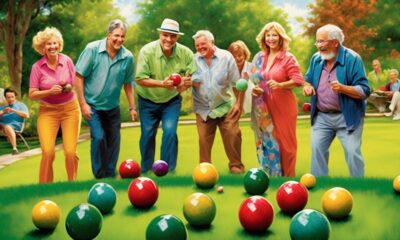
 Vetted4 weeks ago
Vetted4 weeks ago15 Best Lawn Games for Adults to Elevate Your Outdoor Gatherings
-

 Vetted3 weeks ago
Vetted3 weeks ago14 Best Stationery Brands for Your Next Writing Adventure
-

 Beginners Guides1 week ago
Beginners Guides1 week agoSwinger Porch Light Color























